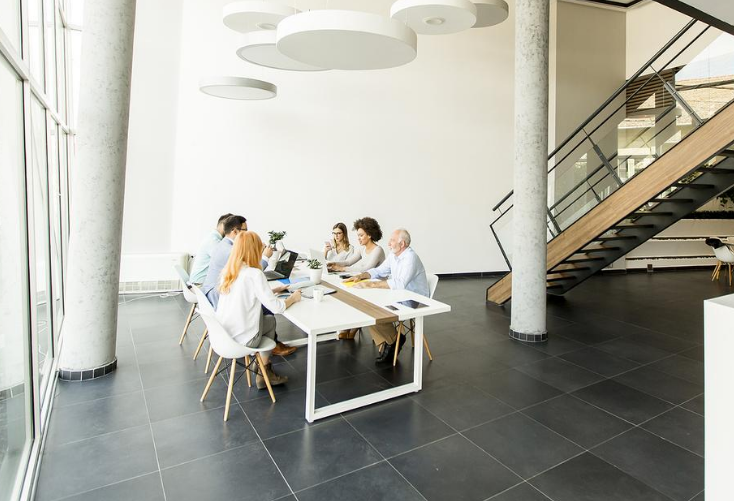Hand selected flexible workspace news from the most reliable sources to keep you ahead of the pack. We find all the latest news, so you don’t have to. Morning and afternoon updates. Stay in the know.
Here’s what you need to know today:
- How Coworking Firms Are Adjusting To The New Normal NEW
- The Role Of CIOs In The Future Of The Workplace NEW
- How Coworking Spaces Are Planning For The Future NEW
- Creating A Human-centric Workplace
- Accor Offers New Hotel Office Concept
- Are Satellite Offices Truly Sustainable?
How Coworking Firms Are Adjusting To The New Normal
Coworking spaces have been left largely vacant in the midst of the pandemic, forcing operators to rethink their strategies and pivot away from the traditional, close-knit atmosphere of these shared workspaces.
For instance, Granite City Coworking Folsom, California has started offering more flexible options, such as pausing memberships at no extra cost and allowing members to skip payments.
According to Molly Weber, cofounder and chief experience officer at Sacramento-based coworking firm The Urban Hive, the company has to make major adjustments to continue supporting members throughout these unprecedented times.
“When we reopened in June, we put a number of safety measures in place, including a complete redesign of our spaces and reducing occupancy to one for every 500 square feet, ensuring that nobody ever needs to be less than 10 feet away from their coworker,” said Weber. “Thankfully, our spaces are wide open and quite conducive to physical distancing. We have also implemented “sanctuary spaces” that are clean, private rooms or offices that our members can book out for the day, week or month.”
Weber added that physical workspaces are needed for many workers who are struggling with isolation and are in need of connecting with other members. For members continuing to work from home, they can still socialize with one another through the company’s Slack channel, as well as a new community app that the firm will launch in the next few weeks.

The Role Of CIOs In The Future Of The Workplace
Organizations have undoubtedly faced their own obstacles and pivoted from their regular practices while trying to operate in a pandemic-ridden society. But once it’s over, what can we expect from the workplace?
For starters, remote working is not going anywhere. Now that organizations large and small understand that operations can continue with workers remaining at home, working in an office will become less popular.
However, with this transition in mind, companies need to have the infrastructure that supports remote working. This means chief information officers will need to branch their security protocols beyond the walls of a single office. Employees will have to be equipped with tools that create a secure home office.
In addition to this, companies are also in the midst of adopting a digitally-fueled workforce. Many businesses were not prepared for the current shift due to a lack of digital infrastructure and technology. Tools, such as the cloud for data storage and artificial intelligence in place of menial tasks, will be crucial in the coming months of a remote workforce.
With clearer business continuity and disaster recovery plans being created, such technology will be essential for the foreseeable future.
CIOs will play a bigger role than ever before as the world transitions to a largely distributed workforce.

How Coworking Spaces Are Planning For The Future
Coworking spaces have become an established part of the workspace industry by offering freelancers, small businesses and even large corporations an alternative work solution that cuts costs and nurtures community.
Now, the coworking industry is suffering as lockdowns run rampant all over the world and these shared workspaces are forced to close their doors to members.
In Nigeria, unlike other parts of the world, rent is paid annually then subleased to startups and individuals. This has made keeping the coworking market afloat that much more difficult.
In the meantime, operators have started planning how to open their spaces in a safe and effective manner. While some are concerned that workers will continue to work from home indefinitely, many professionals are missing a workplace environment that is void of distractions and allows them to connect with their colleagues.
Reopening will unsurprisingly include strict sanitations practices, flexible leases and distanced workstations.
For instance, Tunde McIver, founder and CEO of Lagos-based coworking firm MusterPoint, said the company requires temperature checks upon entrance, face masks, installed sanitation stations and performs routine disinfection of commonly used surfaces.
“We understand that people are prone to disregarding these safety measures after a while,” said McIver. “But in addition to placing reminder signages at strategic points within the facility, we make it a point of duty to reiterate their importance from time to time.”

Creating A Human-centric Workplace
Many progressive companies have realized the value of having a human-centric workspace that focuses on how to create an environment that supports community, productivity and morale.
Now that millions of workers have had to shift to remote working arrangements, creating this type of atmosphere has become more challenging. However, through the use of workplace analytics and technology, business leaders can build a nurturing environment for both remote workers and essential, on-site employees.
For workers who need to be in the office to complete their job responsibilities, the workplace will need to be reconfigured in a way that is efficient and safe. Using analytics, leaders can offer the correct amount of space that can be used to accommodate evolving social and work norms.
That is where occupancy sensors and descriptive analytics come in. Studying this data provides insight into how much space is used, while allowing for minimal disruption in maintenance.
Still, this type of technology only scratches the surface to creating a truly supportive workplace. Using a fully human-centric approach should include monitoring beyond just occupancy — it means reviewing the health, stress levels and social behaviors of workers.
Studying the relationship between occupants in the space, such as noise levels, lighting and air quality and furniture arrangements, can allow organizations to arrange the workspace that meets those needs as efficiently as possible.

Accor Offers New Hotel Office Concept
Hospitality company Accor has revealed it will offer a new type of remote working experience through its Hotel Office concept.
Users are able to rent out a hotel room to get their work done in a clean, safe space free from home-related distractions. Services range from single-day to five-day packages and users have access to the room’s amenities, as well as the hotel’s facilities.
“With millions of people adapting to new ways of working, we have been inspired to support this trend by offering a unique office experience, blending the need for quiet dedicated working spaces with all the convenience and amenities of a hotel,” said James Wheatcroft, Vice President of marketing for Accor Hotels, Northern Europe.
Hotel Office is available at 250 UK and 70 Northern Europe hotels, with Europe expansion plans on the horizon.

Are Satellite Offices Truly Sustainable?
Millions of workers have left the office to work in the safety of their homes as the ongoing pandemic rages on. The workforce saw an exodus of people who no longer have to travel to large cities on their commute and can continue to work from the comfort of their suburban homes.
Now, with many companies maintaining their operations and even improving productivity, organizations are reconsidering their need for office space.
While it appears that remote working is not going anywhere, some workers prefer to be in an office setting where they can have in-person collaboration with colleagues. The solution to this would be adopting satellite offices across the suburbs instead of massive complexes in the heart of metropolitan areas.
Using smaller satellite offices provides workers with a chance to work together a few times a week, while providing a work environment that has less distraction and more office amenities.
However, when a company decides to implement 10 separate locations opposed to one large one, maintenance can become more of a challenge and can split incentives. This means there are more landlords, renters and operators in the mix, making it difficult to keep everyone on the same page.
“A larger site campus may be able to put in more technologies because you have greater control over that property,” said Kyle Goehring, executive vice president of clean energy solutions at JLL. “Whereas if you’re in much smaller sites and you have multiple tenants, you may not be able to implement an on-site renewable or energy-efficient solution because you’re sharing the asset with multiple parties. You may not be able to get agreement.”



 Dr. Gleb Tsipursky – The Office Whisperer
Dr. Gleb Tsipursky – The Office Whisperer Nirit Cohen – WorkFutures
Nirit Cohen – WorkFutures Angela Howard – Culture Expert
Angela Howard – Culture Expert Drew Jones – Design & Innovation
Drew Jones – Design & Innovation Jonathan Price – CRE & Flex Expert
Jonathan Price – CRE & Flex Expert













